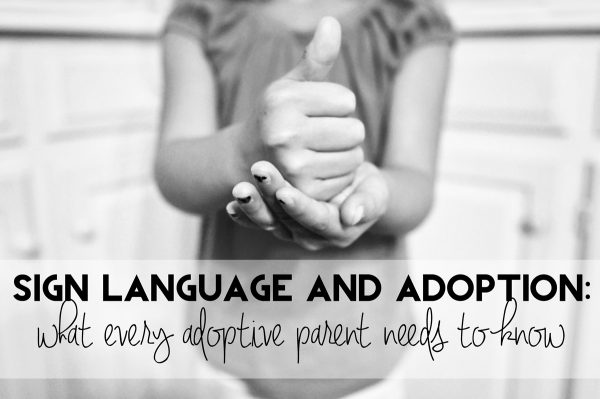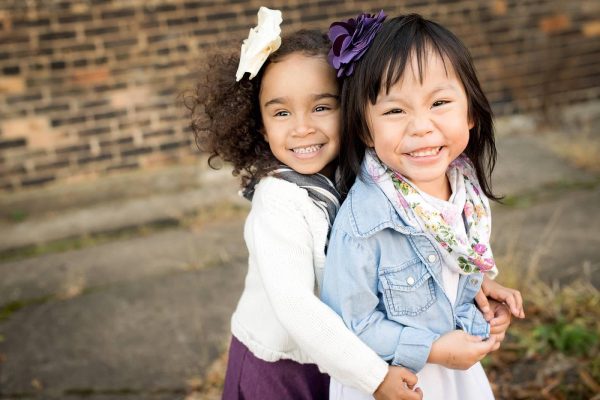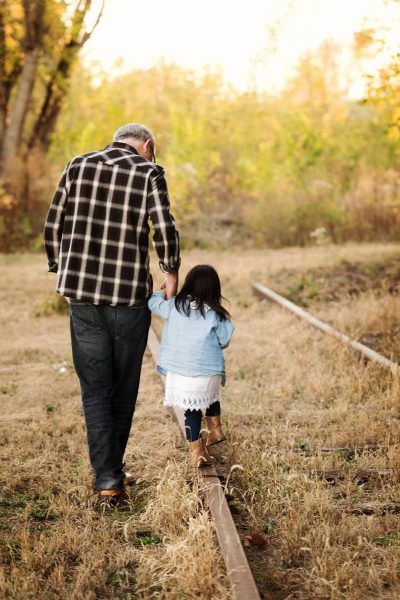
For us, moving forward intentionally with American Sign Language (ASL) became a part of our every day. It might look different for you and your family, and that’s totally okay. We didn’t set goals, or have designated time set aside for ASL instruction – but for some that may be a great way to get going on purpose. Do your thing. As you start introducing ASL, you will get a feel for how your family responds. How ever you decide to step into using ASL, present it to your family in a way that each of you sees the benefit and the joy it can bring into your home. Most of all, have fun with it!
There’s no perfect or standard way to get started, so I’ll just share what we chose to do and what we learned along the way. And I’ll list some resources that are helpful as well.
Depending on the age of your children, you may want to take the time with your older blessings to dig into how ASL was born. It’s quite a beautiful story, and a great opportunity to look at this chapter in history and how one man took the time to care. It was our 16 year old daughter who was doing a research paper for her high school ASL class who shared with us about how Dr. Thomas H. Gallaudet had compassion on his neighbor’s daughter, who was deaf. He was determined to give her language. Fast forward over 100 years and look what his love for others has done! Don’t miss out on sharing with your family the history of ASL. One man saying yes with love towards his neighbor has changed the world.

When we brought our daughter Tessa home, she was 27 months and had a few signs already. Tessa is hearing, but has significant speech delays, so giving her a voice was critical.
As it is with many of our little ones, food is a big deal. We could have started with signs of things around the home, animals, or basic conversation, but we realized pretty quickly that giving her signs for her favorite foods was where we needed to get started.
Our foods had new smells, textures and names that she had never experienced. And we could see that trying to verbally produce the name for something she wanted was stressful. It was important for us to try to make meal and snack time as stress-free as possible. (To start out, let me make a point to say that we always say the word as we sign it. That is very important for our little ones who have any amount of hearing or verbal skills.)
Let me give an example of how a mealtime conversation might go…
“It’s time for breakfast! What would you like for me to make for you this morning?” I might use just two signs here, “breakfast” and “make” while I’m speaking… “Would you like pancakes (sign) or cereal (sign) with milk (sign)?” I then sign and say pancake, cereal and milk one more time as they consider their options.
You might be surprised how quickly they give a sign for one of the options. You may need to use your hands on theirs to help manipulate the sign. Feel free to repeat the sign and say the word at this point several times, being careful not to withhold food that is ready to eat during instruction.
If the meal is made, talk about what you are eating…
“Let’s sit down and eat dinner.” You could simultaneously give the signs for “sit” and “eat”. “We are having noodles tonight.” Then give the sign for noodles. “Can you show me with your hands the sign for noodles?” Let the whole family join in learning the sign for the foods you are serving.
It’s very common for me not to know the sign for the foods, I’m very dependent on my 18 and 16 year old daughters who know ASL very well to give me the sign I’m looking for. If they would be reading this right now they would be laughing and shaking their heads yes! They are so very patient with me.
But when they aren’t around, I grab my phone and have a couple go-to sites. I’ll share those shortly. All that to say, I’m often learning the sign just moments before I’m teaching it. You can totally do this!
Often the conversation might be more like this…
“Do you want ketchup with your fries?” Oh stink… what’s the sign for ketchup? Anyone? Where are your big sisters? Anyone? No? Ok, hold on, let me go look it up.
Just keeping it real friends. I’m no pro.
As we moved on to other signs, we looked for opportunities to give new signs throughout the day. As the girls would be playing, I’d look for ways to give signs for some of their favorite things, “book”, “baby”, “jump”, “dog”, and so on. While reading a book, I’d give a few signs, “blue”, “chicken”, “sleep”…
Honestly, looking back, I didn’t give signs all day long. I think we can overwhelm their little minds if we interject all day long, sign after sign. Take your time with it, and be patient.

We have had moments where the girls would be super hungry for additional signs. Maybe I would give a sign for an animal, they would learn the sign and then one of them would then make sound of another animal. Go with it. When they are done, they will let you know. Don’t feel the pressure to go around the zoo in your mind and give sign after sign, but do give them the signs they are asking for. Go at their pace.
In the ASL community, it is appropriate that a sign name be given to the friend or family member. One doesn’t choose their own sign name. Our daughters were given sign names by our friends’ son who is deaf. Often a sign name is the signed first letter of their name used in a way that focuses on a special characteristic. Our daughter Emma has a big dimpled smile, so our friends’ son gave her sign name as the letter “e” twisting next to her cheek to indicate her dimples. Tessa has his heart (little crush going on) so he gave her sign name with the letter “t” at her heart.
Within your family, there is benefit to giving each other sign names. Have fun at dinner one night working on what they will be. Sign names come in very handy. This summer I have used sign names often at the pool. I might look over at one of my older kids and sign, “Where’s Tessa?” They would sign back, “With Clayton.” No need to yell across the pool. I have loved this about using ASL… we don’t have to yell anymore.
In church, my son might get my attention and give the sign for bathroom. Often I sign back, “No, wait.” Because, my goodness, if you can sit through an entire movie at the theater, you can sit through a message during the church service. He’s caught on so now, as we head into service, I’ll see him sign “bathroom” and off he goes at an appropriate time. Practicing ASL as a family is so very practical.
I’m terrible at fingerspelling, so for me sign names rock. Fingerspelling starts with learning the alphabet and ASL signs for each letter. When reading fingerspelling, it’s the sounds that you are ‘hearing’ in your head that gives you the word that is being spelled out. Fingerspelling is used initially for names, but once a sign name is given then their names aren’t fingerspelled. Look up a sign for items first and, if there isn’t a sign, then you would fingerspell it.
At this stage – our girls are preschool age – we really don’t fingerspell. But we have learned the alphabet song right along with the ASL alphabet. Learning the sounds for each letter while giving the sign for the letter is next, so when fingerspelling comes, they’ll have a solid foundation of knowing the sounds and signs for the letters.
There are many words that our daughters really struggle with articulating, despite them trying hard to verbalize, sometimes I just don’t know what they are trying to communicate. When this happens I try this first, “Can you show me with your hands?” or “Do you have the sign?” If they don’t, I jump on giving them the sign so we can reduce the frustration, always repeating the correct way to pronounce the word.
As we are pretty far into this, we’ve been enjoying the retention that they’ve shown as well as how just a sign can give them the clue they need to pronounce the word. For example, Ava struggles with retrieving labeled words. We know she knows the answer, but often struggles to retrieve it and plan it out. We love seeing how in this situation we just give the sign (no words verbally) and she will retrieve it verbally all on her own! This is huge for her! So, if I show her a yellow balloon and ask, “Ava, what color is this balloon?” she might say nothing at first, or say blue. We know she knows it’s yellow. So I will sign “yellow” and that’s all it takes, she will confidently blurt out “yellow”. Love how it’s building her confidence!

Let me go ahead and give you some great places to get started, resources that we have found helpful.
Signing Time is our top fav for the kids. I don’t think it’s on NetFlix anymore, but you can find some of their videos floating around to purchase and sometimes on YouTube. It’s filled with lots of songs and practical signs. I love that there are always kids of all abilities and ethnicities signing.
My Smart Hands is a YouTube channel that has great instruction. I’ve used these videos to introduce ASL to children’s songs. We love searching for our favorite bedtime or children’s songs with ASL on YouTube.
You may have some ASL children’s resources that you love, if so, please share in the comments!
For me, here are sites that are my favs… ASLpro.com is a simple way to look up the words you want to see the sign for. Each word has a video, which is really the best way to learn signs, not a picture. It’s important to learn and use the facial expressions that go along with many signs and sometimes a little movement may change the sign completely (“ketchup” and “promise” are similar with just an added movement). This site has a Religious Signs segment which I love! So here you can not only access the Word Dictionary, but you can also take advantage of the quizzes they offer. You can also learn Conversational Phrases and access ASL for Babies here as well.
Signing Savvy.com is another helpful site, similar to ASLpro. DeafMissions.com is a unique site that my oldest daughter shared with me. Her ASL teacher had her students go to this site daily to watch the devotions that they post. You can do this as a family, watch the devotions being signed and read along as well. Watching someone sign conversations is really helpful – especially seeing how signs are used practically and how the signer uses facial expressions.
Remember to give your little ones signs not only for things, but for feelings as well. It’s not just our desire for them to be able to sign what they want, but to be able to express how they feel. Watch how ASL connects to their little hearts and let it be a part of their healing process.
Our daughters are improving in their speech, they both have come so far, but they continue to struggle with articulation and motor planning. When we bring ASL into the language journey we get to see success and in turn their confidence in our relationship builds. Even at age 3 and 4 years, the girls aren’t able to say “I love you” with great articulation, so when I leave the house, the little ones standing at the door waving good bye and blowing kisses, it’s the flash of the “I love you” sign that gets me every time. Every. Single. Time.
We know the verbal words will come, in their own way and in their own time, in the meantime we love seeing the relief as our daughters retain and give the signs that have been gifted to them. We truly see it that way, ASL is a gift of connection and building trust with our daughters. And this gift has so much more to give to all of us.
– guest post by Amber

























I am loving this series. We are Australian so are using Auslan not ASL, but all the same principles apply, the signs are just different.
Our newest family member has been home less than 2 months. At 1 and a half and with a CLCP repair she’s not producing much verbal language but wow does she communicate with the few signs she has already learned. It has been such a blessing to be able to help her communicate her needs. We look forward to her being able to communicate even more as she picks it up.
Thanks so much for sharing your family and story with us all!!